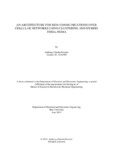| dc.description.abstract | Machine-to-Machine (M2M) communications is regarded as one of the most essential technologies in the
future communications system because of enabling enormous wireless machines to communicate without
human interference. M2M communications is increasingly growing its popularity in present and future
cellular networks for providing huge variety of available connectivity solutions, various ubiquitous services
and global coverage. The demand of low energy consumption and high throughput applications, and the
emergence of M2M communications has already drawn notable attention of many academia and industries.
However, M2M communications will be experiencing multifarious challenges and complexities in the
future standardization of 5G cellular networks. Therefore, robustness in M2M architecture is absolutely
essential to manage numerous amount of machines and to cope up with their access loads effectively and
efficiently. In light of this, this research thesis proposes a novel architecture for M2M communications over
5G cellular networks. k-means dynamic clustering for machines as well as energy based cluster head (CH)
reselection method is applied in order to balance the power consumption within the machines to increase
their battery life. For communication between CH and member machines, time division multiple access
(TDMA) is proposed. On the other hand, for communication between CH and BS, non-orthogonal multiple
access (NOMA) technology based power coding and successive interference cancellation (SIC) is
implemented.
Performance of the proposed architecture is evaluated through extensive simulations for evaluating the
system performance considering perfect communication and the newly developed 3D 5G wireless channel
models. Impact of system parameters including number of machines, cell radius, transmit power and channel
models on system performance are examined. Extensive simulations are carried out for evaluating the
system performance considering the newly developed 3D 5G wireless channel models in terms of energy
efficiency, life-time of machines and throughput. Our proposed M2M communication architecture identifies
that with CH reselection and clustering technique, the number of transmission cycle, throughput and energy
efficiency can be increased significantly. The proposed TDMA-NOMA based hybrid multiple access
technique has substantially decreased the communication delay than the TDMA-TDMA based system. In
addition, proposed M2M communication architecture will be extended for multi-cell cellular network
considering inter-cell interference. | en_US |

